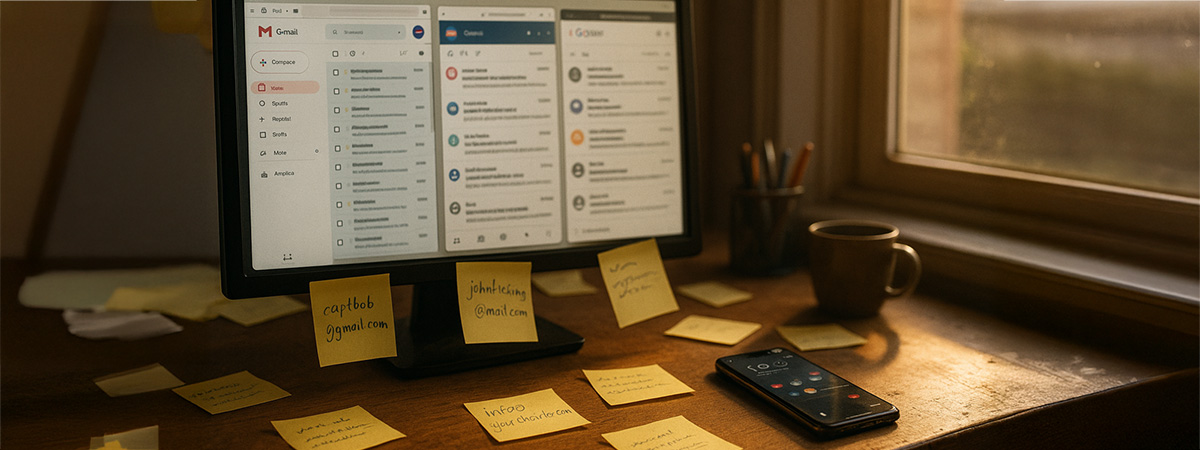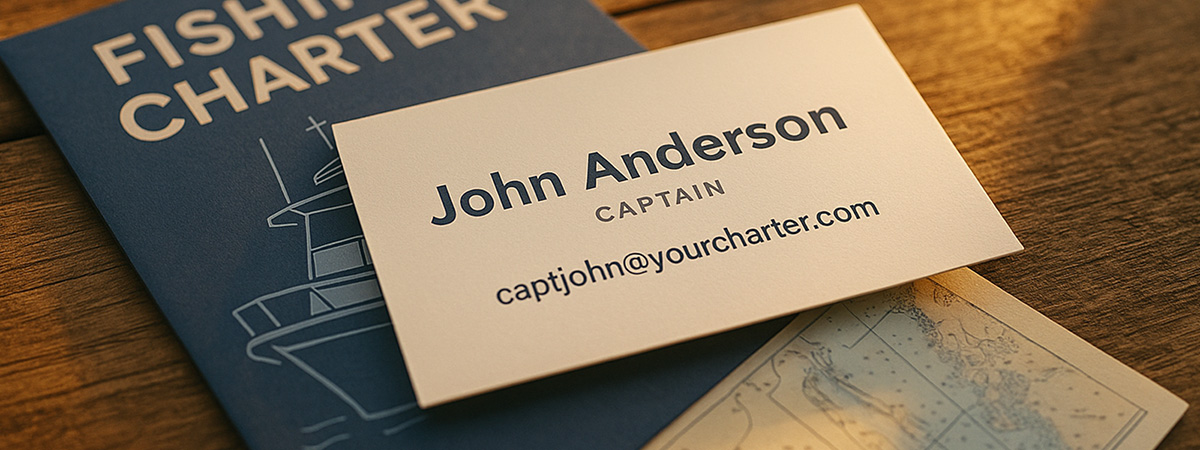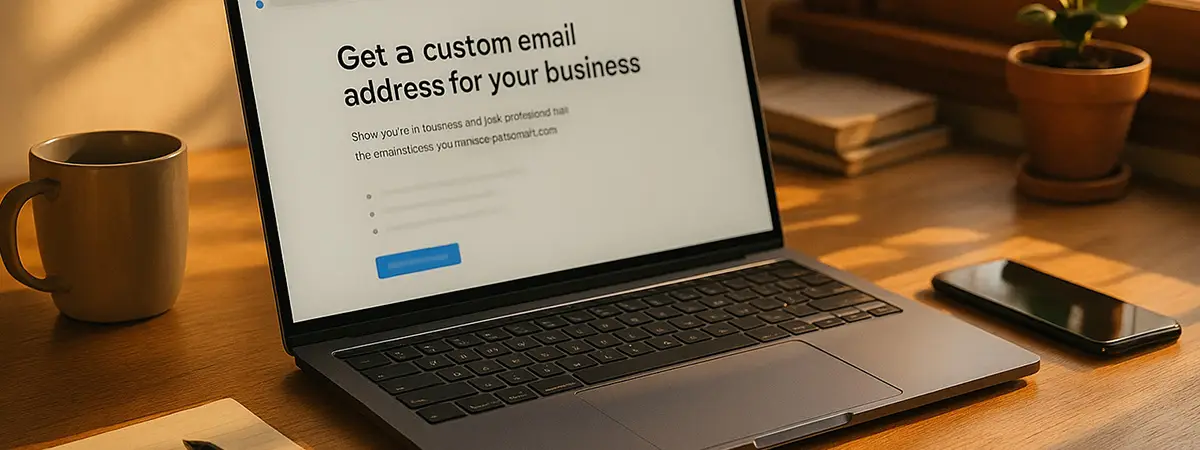If you’re like a lot of fishing guides and captains, you’ve been using the same Gmail, Yahoo, or personal email address for years. It works fine to send messages, book trips, and communicate with clients. So why change?
The truth is, sticking with a personal email for your charter business can quietly cause problems behind the scenes. Missed inquiries, undelivered booking forms, and a lack of professionalism may be costing you trips without you even realizing it.
The good news? There’s an easy fix—and it’s one of the simplest upgrades you can make to look more professional, build trust, and avoid losing out on paying clients.
The Problem With Using a Personal Gmail (or Similar)

There’s no doubt Gmail and other free email services are convenient. That’s why so many captains use them. But when you’re running a business, convenience shouldn’t come at the cost of credibility or reliability.
Here’s why using a personal email can hurt your charter business:
- It looks unprofessional – Clients expect to see a business email like info@yourcharter.com, not captainbobfishing67@gmail.com.
- It causes email delivery problems – Website forms and booking systems can flag Gmail addresses as suspicious or send them to spam. If a trip inquiry never makes it to your inbox, that’s money lost.
- It creates a management nightmare – Many captains have set up multiple personal email addresses over the years, with Google Business, Analytics, Ads, booking platforms, and social media tied to different accounts. Tracking which email controls which account becomes nearly impossible and makes it hard to manage or connect services.
- You risk losing account access – If your business Google account, Ads account, or Google Business Profile is tied to a personal Gmail and you lose access, it can be difficult—or impossible—to recover.
Switching to a domain-based email solves all of these issues at once.
The Benefits of a Domain-Based Email

The good news is that solving this problem is simple and affordable. A professional, domain-based email—like info@yourcharter.com or captjohn@yourcharter.com—instantly boosts your credibility and helps prevent email delivery issues. Here’s why it’s worth making the switch:
- It looks professional – Clients and partners immediately recognize your business as legitimate and trustworthy.
- It improves email deliverability – Booking inquiries, website forms, and client messages are far less likely to be flagged as spam.
- It centralizes your accounts – Tying your Google Business Profile, Google Ads, Analytics, social media, and booking platforms to a single branded email keeps everything organized and easier to manage.
- It adds security and recovery options – Domain-based email providers offer proactive security, spam filtering, two-factor authentication, and easier recovery if passwords are lost or accounts are compromised.
- It gives you long-term control – If you sell or pass on your business, having everything tied to a professional email makes the transition much smoother.
- It’s still Gmail if you want it to be – Many guides choose Google Workspace (formerly G Suite), which gives them a custom domain email with the same Gmail interface they already know and love.
- It’s inexpensive – Most domain email accounts through providers like Google Workspace or GoDaddy cost less than $6 a month—a small price for a big upgrade.
A domain-based email address solves nearly every problem that personal email causes, and sets your business up to grow with fewer headaches.
A Common Scenario: Website Form Emails to Gmail

Many fishing guides run into this issue without even realizing it. They set up their website with a contact form or booking inquiry form that sends submissions to their Gmail address. It works for a while—until it doesn’t.
Why your form emails stop arriving
Here’s what happens behind the scenes: when your website tries to send an email “from” a Gmail address but originates from a different server, many email providers—including Gmail itself—flag the message as suspicious or block it altogether. That’s because the message fails common authentication checks like:
- SPF (Sender Policy Framework) – Verifies the sender’s IP address is authorized to send emails on behalf of your domain.
- DKIM (DomainKeys Identified Mail) – Ensures the message was not altered in transit and is actually from the claimed sender.
- DMARC (Domain-based Message Authentication, Reporting & Conformance) – Tells mail servers how to handle emails that fail SPF or DKIM checks.
The result? You never get the inquiry. You miss out on a trip. You may not even know it happened.
There is a better solution
Some website tools can bypass this using an SMTP plugin (such as WP Mail SMTP) to send email directly through Gmail’s servers. While this can improve deliverability, it requires setup most captains won’t want to mess with, including creating app passwords and managing SMTP settings. It also introduces risks if the account is ever lost or settings are changed.
The better option? Use a domain-based email address as the “from” address for website forms. When combined with a verified email sending service (like SendGrid), your forms will consistently land in your inbox without fail. Plus, your reply-to address can still be any address you choose—even Gmail if you prefer.
Bonus Benefit: Looks Better on Your Website

There’s one more simple but powerful reason to switch to a domain-based email: it just looks better on your website, business cards, and social media profiles. An email like info@yourcharter.com or captainjohn@yourcharter.com reinforces that you’re running a professional operation. It tells potential customers you’re a legitimate business they can trust.
On the other hand, seeing a free personal email—especially something like bigfishcaptain1987@gmail.com—can make you look less established or even unprofessional. It’s a small detail, but one that leaves a big impression when customers are deciding who to book with.
What We Recommend

If you want to avoid lost inquiries, look more professional, and make managing your business easier, switching to a domain-based email is a no-brainer. The process is simple and affordable.
We recommend setting up your business email through a provider like:
- Google Workspace (formerly G Suite) – Lets you use Gmail with your own domain. You get the same familiar Gmail interface plus added business features and security.
- GoDaddy Professional Email – A budget-friendly option that provides reliable email hosting and basic security features.
In either case, the cost is typically less than $6 per month—a tiny investment compared to the value it adds to your charter business.
And if you work with a marketing partner or web professional, they can easily help you set it up and connect it to your website and booking forms.
Future-Proof Your Business
Switching to a professional, domain-based email address is one of the easiest ways to upgrade your charter business. It improves email deliverability, adds credibility, keeps your accounts organized, and protects your business for the long haul.
Even better, it’s a one-time setup that pays off for years to come. Your website, Google Business Profile, Ads account, booking platform, and customer communication will all run smoother and look more professional.
If you’ve been relying on a free Gmail or Yahoo address, now is the time to make the change. You’ll never regret having your email tied to your brand.
Checklist: Is It Time to Get a Domain Email?
- Are you using a Gmail, Yahoo, or similar free email for your charter business?
- Have you ever missed an inquiry because it went to spam?
- Do you have multiple personal email addresses tied to different business accounts?
- Is your email the same across your website, Google Business Profile, and booking platforms?
- Does your current email look professional to potential clients?
If you answered “yes” to any of these, a domain-based email is a smart upgrade that will save you time, hassle, and potentially lost trips.